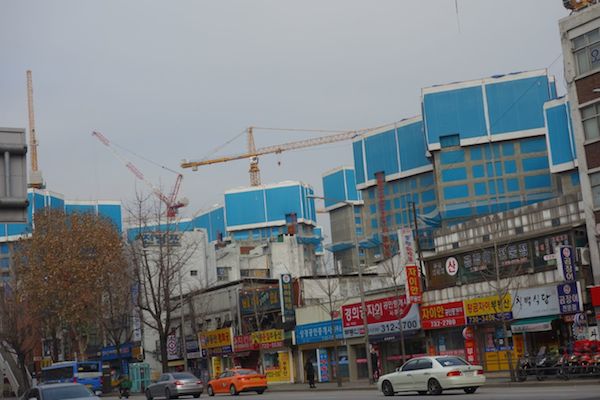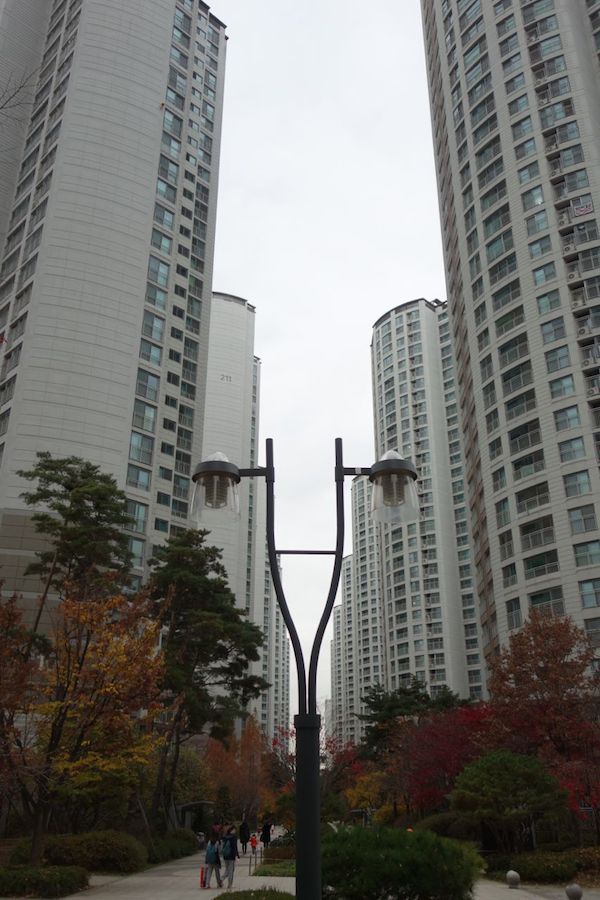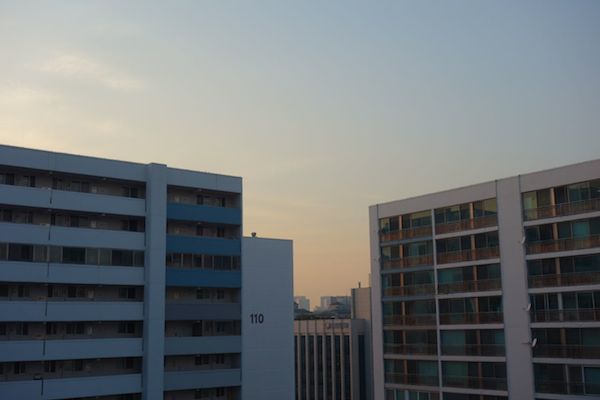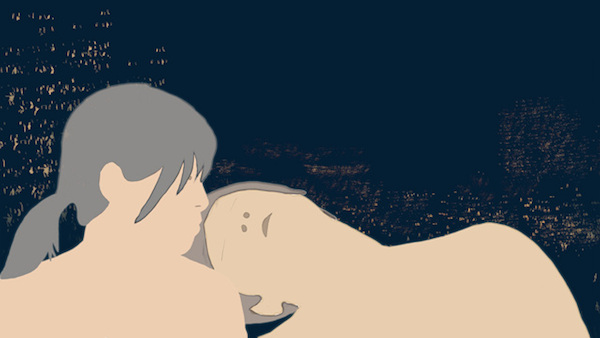My friend Darcy Paquet, who preceded me to Korea by almost twenty years and in that time became a famous film critic here, once wrote a piece in the Hankook Ilbo (한국일보) about having to readjust his sense of space from that of the rural Massachusetts in which he grew up to that of Seoul. “It’s not just the crowded streets and buses that I had to get used to, but also the sense of always having people around me,” he wrote. “Living in a large apartment complex, with so many other families going about their lives behind my walls and under the floor, took some getting used to.”
He quotes friends back in America: “I can’t understand why anyone would want to live in one of those apartment complexes, like bees in a hive.” In my experience as well, more than a few Americans express their feelings about the density of a city like Seoul with beehive imagery, assuming they don’t jump straight to the word “dystopia.” I’ve given a lot of thought to how movies create urban dystopias, and Western ones tend to signal hellishness with height, Blade Runner‘s treatment of the Los Angeles of the future being the most influential example, but however expressed, the notion that bad things happen in tall buildings, or that tall buildings cause bad things to happen, enjoys a special prevalence in the Anglo-American mind.
Blade Runner, recall, had an American setting but, in Ridley Scott, an English director. We’ll have another vivid entry in this canon later this year with the release of the new film adaptation of High-Rise, J.G. Ballard’s novel of a luxury London tower block’s near-immediate devolution into an ultraviolent bacchanal. Sometimes I ask friends who insist on calling dense high-rises dystopian whether piloting a metal box down a strip of asphalt in a metal box at seventy miles an hour strikes them as any less so, but Ballard, who made the ravages of the automobile the object of grim fascination in the David Cronenberg-adapted Crash, beat me to the point.
Why do so many of us Westerners fear and loathe the vertical life? I don’t, so I can hardly find my way to the answer through introspection, but if I did, I suppose I wouldn’t have moved to Seoul in the first place. Seemingly every few weeks I meet someone who has the exact same memory about when they first arrived in the city: “My first apartment building had more people in it than my entire hometown.” You can still find a place to live in a structure under ten stories, but sometimes I wonder how long that will last, given the number of cranes every day visible hard at work on the skyline.
They’re building what I think of as, for better or for worse, Seoul’s architectural signature: forests of ten, twenty, thirty identical (or almost identical) 600-foot-ish towers, differentiated mainly by the three-digit numbers stamped on their outer walls. Often these complexes lack aesthetic distinction, to put it mildly, and come with names that look strange to English-speakers — Brownvill, We’ve, Xii (“eXtra intelligent”), The # — selected, according to the joke that exposes middle-aged Koreans as not quite so piously Confucian as the stereotypes would lead us to believe, to prevent aged, demanding, and confused grandparents from finding their way there.
One sometimes hears this type of housing condemned (rhetorically, not legally, though the first few generations that rose after the Korean war certainly weren’t built to last) as a force that cuts down older, lower-rise neighborhoods — neighborhoods with the ambiguous quality of “character” — like a scythe through wheat, replacing them with nothing better than architecturally cookie-cutter monotony, and a monotony often unaffordable to the demolished areas’ former residents at that. But the greatest architectural loss, in some eyes has come at the expense of the hanok (한옥), a form of traditional single-story Korean house whose numbers decreased dramatically in the 20th century.
As for what, exactly, caused so many hanok to disappear, different people blame different other people: ruthless corporate builders, Koreans blinkered by their desire for modernity, the Japanese. A preservation movement has cohered around the hanok, but even that has its divisions: some hanok-lovers see what old specimens still stand as, for cultural, historical, and other reasons, worth protecting as they are; others want to keep the form in use, but to do so by producing new-built hanok with such comforts as modern plumbing and heating. (The architect Hwang Doojin mentions, in a TED Talk, always having to address the same question about his new-built hanok from clients: “But isn’t it cold?”)
At first glance, this debate’s battle lines look drawn between Koreans and Westerners, the former willing to sacrifice tradition and “authenticity” (another uselessly vague term) in the name of amenity, and the latter, longing for the bygone days when the “Land of the Morning Calm” merited that nickname, who fight for a cultural legacy of whose importance the country itself may have lost sight. It brings to mind the controversy over last year’s demolition of the Olympics-era Hotel Okura in Tokyo, at which many Western admirers raised a fuss, but at which the Japanese themselves seemed only to shrug, a vivid illustration, to my mind, of the Western conflation of, and the Eastern separation between, a culture and the artifacts of that culture.
But on closer inspection, the picture in Korea starts to look more complicated. Some of the better-known hanok advocates do indeed come from the West, but that reflects the Western preference for low-rise historical buildings as much as it reflects the need, real or imagined, for things Korean to gain the imprimatur of foreign approval before they can be successfully sold back to the Koreans themselves. Witness the much-promoted “Korean Wave” of popular culture, which values Korean music, movies, and television shows to the exact extent that they raise enthusiasm elsewhere.
Yet I do still see my fellow Westerners, especially Anglo-Americans — even more especially Americans — as, in the main, a psychologically rural people. Unlike many Koreans, the countryside represents to them not a place from which to escape to the city, but an escape from the city. Most Americans, of course, don’t live in the rural countryside, nor do most Americans live in the few pockets of their nation where robust urban life has arisen; most Americans live in one kind of suburban or exurban compromise or another, and no matter how intellectually sophisticated, usually bring their rural desires — for space, isolation, autonomy, land ownership, and a freedom from societal encumbrance — with them.
This mismatch between these deep-seated attitudes of Americans (a people who tend to make sarcastic mooing noises when more than a few dozen of them get told to move in one direction at once) and the settings in which they actually live results, I would submit, in many of the ills of American life today, from the much-dramatized malaise of the suburbs all the way up to the whole gun thing. Seoul has suburbs, too, and suburbs often moved out to for similarly marriage- and family-oriented reasons. Some of the newer ones look like slightly askew imitations of the American cul-de-sac-and-picket-fence model, but the majority of them take the form of even thicker clusters of even taller towers than the ones in the city proper, usually accessible without great difficulty by train from the city proper. (The notion that transit is for poor people, like the notion that tower blocks are for poor people, hasn’t taken hold here.)
The heads of the Westerners who regard that as anathema must fill with visions of Pruitt-Igoe in St. Louis, Cabrini-Green in Chicago, Aylesbury Estate and Robin Hood Gardens in London — just a few of the infamously failed high-rise housing projects of the West. All built ostensibly with the best of intentions (though some consider them built-to-fail warehouses for poor minorities), they all quickly became victims of neglect, crime, demolition, and, ultimately, status as playing cards in service of the argument that associates the vertical life with poverty, ugliness, squalor, and moral decay, the oppressiveness of whose very architecture propels even their most good-hearted residents to rebellion. “The week it opened,” recalled architect Peter Smithson, co-designer of Robin Hood Gardens with his wife Allison, “people would shit in the lifts.”
I don’t hear of many Seoulites doing that sort of thing, but one might object to the comparison, arguing that the capitals of Asia never suffered the postwar exodus to the suburbs that bled American and English cities dry of their residential population, turning them for decades into bywords for filthy, decrepit centers of desperate lawlessness. But I mean to highlight that very difference: a city like Seoul, a city taken seriously, has only grown more desirable with time, resulting in its metropolitan area now hosting half the population of the entire country (the equivalent, in America, of rolling New York, Los Angeles, Chicago, and Washington, DC into one and giving it a population of 150 million).
To meet this desire, Seoul has grown and continues to grow outward, but much more so upward. The Smithsons and other midcentury architects, now thought utopian dreamers, spoke of creating “streets in the sky,” and I use the very same language to describe the appeal of the vertical life in Asia: just as you pass all manner of shops, cafés, bars, and services as you walk down the street, you do the same as you ascend from one floor to the next in a building. Japanese cities, which allow near-complete freedom in the zoning of floors — a restaurant on the ground, an office above that, a club above that, a bookstore above that, with residences scattered here and there — have realized that concept to perfection.
But the towers of Seoul still do a more exciting job of it than American ones, subject to rigid zoning laws dictating what can go where, hindering the essential aspect of urbanism I call “dimensionality”: a three-dimensional city provides variety on one dimension as you move horizontally through it, on another dimension as you move vertically through it, and — perhaps the specialty of a city that changes as fast as Seoul does — on another dimension as you move through time. The more fully three-dimensional the city, the more conducive to, and the more it requires, life lived vertically.
At least in aesthetic sense, though, I do like hanok, much as I appreciate the midcentury modernist houses of Los Angeles. But to purchase and occupy your very own building strikes me not just as an act of increasingly Croesan ostentation, but as a terrible inconvenience besides. I’ve so far found, just within my own modest fifteen-story building, a market, a bakery, a hair salon, a cleaners, dentists, and a language-study café. The population density created by the even taller towers around it ensures that I can find everything I might need in life within ten minutes’ walk, a condition hard to imagine in America even amid the country’s celebrated urban renaissance now underway.
I dream that, when next I live in Los Angeles, the city’s vertical life will have come into its own. But much work remains to be done, not just in terms of putting up buildings and infrastructure but of shedding inhibitions over going about life above, below, and beside other people in closer proximity. Despite its vast potential, Los Angeles, a city where every project over a certain size gets denounced in some quarter as a “monstrosity,” continues to labor under the common notion that, while those beehives might be all well and good for the youngsters and the hipsters, we live our real lives in detached houses, away from business and industry, and not even among many other residences — in other words, in one dimension.
How to chip away at this prejudice? Maybe we can start with the brief but memorable viewing experience of City, a short film by Korean animators Kim Ye-young and Kim Young-geun that Darcy included in his column. Its elegantly striking concept envisions the routines of city life — elevator rides, morning commutes, the tasks of work — with the manmade environment, from concrete to clothes, wholly stripped away. “It’s the last image in the film that I remember in particular,” Darcy writes. “At the end of the day, hundreds of people are sleeping in an apartment complex. Because we can’t see the floors or objects in the apartment, it looks like they are floating. There’s something unexpectedly intimate about the image. They resemble not bees in a hive, but birds flying through the air.”
You can follow Colin Marshall at his web site, on Twitter @colinmarshall, or on Facebook. Catch up on the Korea Blog’s archives here.







